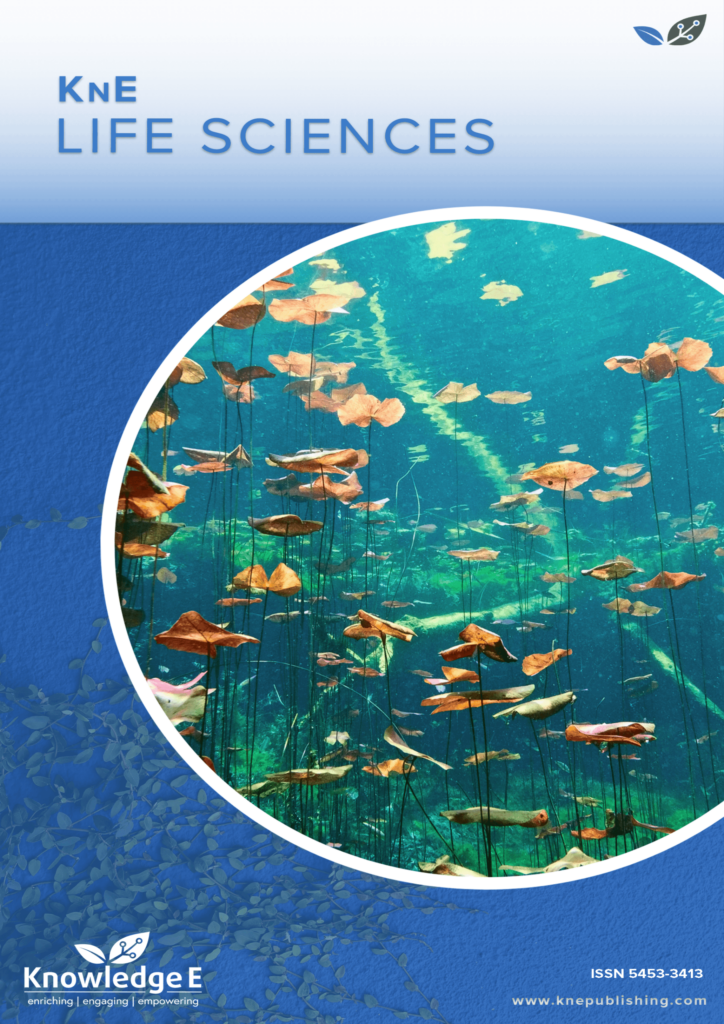
KnE Life Sciences
ISSN: 2413-0877
The latest conference proceedings on life sciences, medicine and pharmacology.
Viability of Trichoderma harzianum Grown on Different Carrier Formulation
Published date: Nov 26 2017
Journal Title: KnE Life Sciences
Issue title: 2nd International Conference on Sustainable Agriculture and Food Security: A Comprehensive Approach (ICSAFS)
Pages: 95-101
Authors:
Abstract:
The suitable carrier composition is needed to ensure the effectiveness of Trichoderma harzianum as inoculant of biocontrol, plant growth promotion and decomposer fungus. The research aimed to investigate formulation of carrier to enhance of Trichoderma harzianum viability was conducted from January till June 2015 in Laboratory. Testing of the compotition of carrier materials on viability of Trichoderma harzianum using a completely randomized design consisting of 9 treatment compotitions of peat soil, cow manure, biocharcoal and nutrient. The observed variables were the population of Trichoderma harzianum (cfu/g) on a regular basis i.e2, 4, 8, 12, 16, 20, and 24 weeks after production, pH and moisture content (%) of media. The result showed that the different carrier formulations resulted number of spore varried, from 1.33 x 105cfu/g to 7.98 x 106cfu/g. The best formulation of Trichoderma harzianum was peat soil 40% + cow manure 40% + biocharcoal 10% + nutrient 10% with the maximum population count achieved 7.98 x 106cfu/g after 24 weeks of storage.
Keywords: Trichoderma harzianum, carrier formulation, viability, biocharcoal, nutrient..
References:
[1] Turmuktini, T., T. Simarmata, B. Joy, and A.C. Resmini. 2012. Management of Water Saving and Organic Based Fertilizers Technology for Remediation and Maintaining The Health of Paddy Soils and To Increase The Sustainability of Rice Productivity in Indonesia. Asian Journal of Agriculture and Rural Development 2(4): 536-551.
[2] Sidhu, B.S., O.P. Rupela, V. Beri, and P.K. Joshi. 1998. Sustainability Implications of Burning Rice and Wheat-Straw in Punjab. Economic and Political Weekly September 26, 1998.
[3] Farag, A.A., M.S.M. Ahmed, F. A. Hashem, M. A. A. Abdrabbo, and M. A. AbulSoud. 2015. Utilization of Rice Straw and Vermicompost in Vegetable Production Via Soilless Culture. Global Journal and advanced Researc, 2(5): 800-813.
[4] Hatem, M.H., W.M. Ibrahim, O.M. Kamel, and R.M. Atti. 2008. Production of Compost from Rice Straw Under Prototype Condition. Agricultural Mechanization And Engineering Between Existing and Prospected, 579-590.
[5] Naher, L., U.K. Yusuf, A. Ismail, K. Hossain. 2014. Trichoderma spp.: A Biocontrol Agent for Sustainable Management of Plant Disease. Pak. J. Bot., 46(4):1489-1493.
[6] Mukhlis, H.M. Saud, M. Sariah, M.R. Ismail, S.H. Habib, and HKausar. 2013. Potential Lignocellulolytic Trichoderma for Bioconversion of Palm Oil Empty Fruit Bunches. Australian Journal of Crop Science, 7(3): 425-431.
[7] Rahman, A., M.F. Begum, M. Rahman, M.A. Bari, G.N. Ilias,and M.F. Alam. 2011. Isolation and Identification of TrichodermaSpecies from Different Habitats and Their Use for Bioconversion of Solid Waste. Turk. J. Bio., l35: 183-194
[8] Ramanujam, B., R.D. Prasad, S. Sriram, and R. Rangeswaran. 2010. Mass Production, Formulation, Quality, and Delivery of Trichoderma for Plant Disease Management. The Journal of Plant Protection Science, 2(2): 1-8.
[9] Singh, A.S., B. Panja, and J. Shah. 2014. Evaluation of Suitable Organic Substrates Based TrichodermaharzianumFormulation for Managing Rhizoctoniasolani Causing Collar Rot Disease of Cowpea. Int. J. Curr. App. Sci,. 3(8): 127-134.
[10] Adan, M.J., M.A Baque, M.M. Rahman, M.R. Islam and A. Jahan. 2015. Formulating of Trichhoderma Based Biopesticede for Controlling Damping Off Pathogen of Eggplant seedling. Universal Journal of Agricultural Research, 3(3): 106-113. doi: 10.13189/ujar.2015.030305.
[11] Kresnawaty, I., A. Budiani, and T.W. Darmono. 2010. Population Dynamic of TrichodermaharzianumDT38 in Palm Oil Empty Fruits Bunches Biocharcoal and Peat Soil. Menara Perkebunan, 80(1): 17-24.
[12] Sargin, S., Y. Gezgin, R. Eltem, and F. Vardar. 2013. Micropropagule Production from TrichodermaharzianumEGE-K38 Using Solid-State Fermentation and A Comparative Study for Drying Methods. Turk. J. Biol. 37: 139-146.
[13] Cavalcante, R.S., H.L.S. Lima, G.A. S. Pinto, C. A.T. Gava,and S. Rodrigues. 2008. Effect of Moisture on Trichoderma Conidia Production on Corn and Wheat Bran by Solid State Fermentation. Food Bioprocess Technol., 1: 100–104
[14] Motta, F.L., and M.H.A. Santana. 2014. Influence of Fermentation Conditions on Humic Acids Production by Trichoderma viride Using an Palm Oil Empty Fruit Bunch as The Substrate. International Scholarly and Scientific Research & Innovation, 8(5): 382-389.
[15] Agosin, E., D. Volpe, G. MunÄoz, R. San Martin and A. Crawford. 2015. Effect of Culture Conditions on Spore Shelf-life of The Biocontrol Agent Trichoderma harzianum. World Journal of Microbiology & Biotechnology, 13: 225-232.
[16] Kumar, S., R. Kumar, H. Om. 2013. Shelf-life of Trichoderma viride in Talc and Charcoal Based Formulations. Indian Journal of Agricultural Sciences, 83(5): 566–9.
[17] Baghel, S., P. Dewangan, B. Koma, and K. P. Verm. 2014. Studies on Trichodermaviride Formulations for Enhancing Its Storability. The Bioscan, 9(3): 1313-1316.
[18] Elad, Y., D.R. David, Y.M. Harel, M. Borenshtein, H.B. Kalifa, A Silber, and E.R. Graber. 2010. Induction of Systemic Resistance in Plants by Biochar, A Soil-Applied Carbon Sequestering Agent. Phytopathology, 100(9): 913-921.
